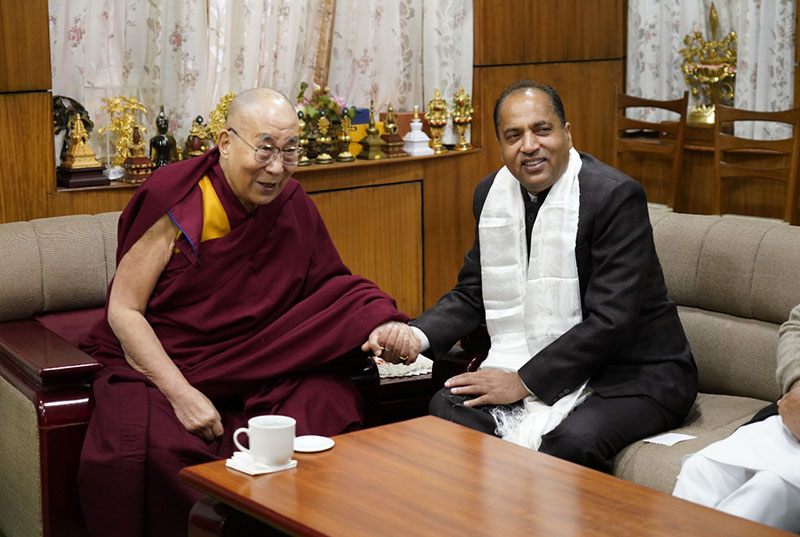Dharamshala, India — The spiritual leader of Tibet, His Holiness the Dalai Lama has called on Jai Ram Thakur, new Chief Minister of Himachal Pradesh to take a leading role in promoting Indian traditional knowledge through the education system.
Himachal Pradesh Chief Minister Jai Ram Thakur on Thursday called on the spiritual leader of Tibet, His Holiness the Dalai Lama at His Holiness’ official residence in Mcleod Ganj, on 1st February 2018. The Chief Minister's office said Thakur met the spiritual leader to seek his blessings. Cabinet Minister Mahinder Singh and other top officials accompanied him.
At the meeting in Dharamshala, HP, India on February 1, 2018, His Holiness advised the 13th HP Chief Minister to be open-minded while carrying out his political duties. His Holiness also highlighted on ancient Indian traditional knowledge and its contemporary relevance. HP CM was advised to take a leading role in promoting Indian traditional knowledge through the education system.
Early January, CM Thakur met President Dr Lobsang Sangay at Circuit House in Chilgari, Dharamshala. The Chief Minister expressed his wish to call on His Holiness the Dalai Lama. Speaker Khenpo Sonam Tenphel, Deputy Speaker Acharya Yeshi Phuntsok and members of the standing committee of Tibetan Parliament in exile also paid an official visit to CM Thakur at circuit House in Dharamshala, on January 31, 2018.
His Holiness returned to his abode on January 31, 2018 after a month-and-a-half sojourn to Bodh Gaya in Bihar where His Holiness gave a series of sermons and presided over the initiation ceremony of over 50,000 devotees from more than 13 countries.
In 1959, His Holiness the 14th Dalai Lama along with thousands of others escaped to India, where he was given political asylum. The spiritual leader has set up a government and rebuilt monasteries where masters pass on their teachings to young monks. Tibetans in exile have succeeded in gradually rebuilding their monasteries, preserving their culture and restructuring their society and keeping it alive, in spite of the extremely difficult circumstances.
For his part, the Tibetan spiritual leader travels around the world spreading a message of Peace and Universal Responsibility. He believes that the common aim of all religions, an aim that everyone must try to find, is to foster tolerance, altruism and love. He retired from politics in 2011. But, as one among six million Tibetans, His Holiness said he will continue to serve the cause of Tibet.
The spiritual leader has cancelled most of his overseas obligations in the new year, including an upcoming visit to United States. His Secretary Tenzin Taklha expressed his regrets in a letter to the Raleigh mayor Nancy McFarlane saying, “It is with deep regret that I inform you of a change in His Holiness the Dalai Lama’s schedule, obliging him to cancel the majority of his travels abroad, including the United States of America.
While there is no medical reason for the cancellation, His Holiness stated late in 2017 that he was unable to recover as quickly from the long flights as when he was younger. His Holiness will be 83 in July. In August of last year, the leader cancelled his trip to Botswana, Africa citing exhaustion and his physician’s advice not to undertake long journeys.
His Holiness the Dalai Lama also has recently appointed his personal representatives or emissaries to attend international engagements or speak on his behalf indefinitely. Citing increasing physical fatigue, His Holiness made the comments while meeting with a group of international youth leaders brought to Dharamshala, India, by the Washington-based Institute of Peace.
Introducing Prof Samdhong Rinpoche and President Dr Lobsang Sangay as his trusted personal representatives or emissaries, His Holiness has urged the United States Institute of Peace to hold more effective meetings in the future, to pave the path for a peaceful, compassionate century.
“I'm 82 years old, and since last year my feeling of tiredness has been much increased,” he told the group during meetings in November 2017. Because he may not be able to maintain a regular international travel schedule, His Holiness said, the president of Tibet's current government-in-exile, Dr Sangay, along with prominent Buddhist scholar and former prime minister in exile, Samdong Rinpoche, would act as his official emissaries or representatives.
His Holiness told the international youth leaders that his two fully trusted representatives can participate as his representative or personal emissaries in future dialogue with the United States Institute of Peace. "I am now 82-year old. Since last year, my feeling of tiredness has been much increased. For more activities in different continents and different countries, I may not participate," His Holiness said, adding: "So I brought two of my trusted friends and emissaries."
"I am retired from political responsibility. Since 2001, Pro Samdhong Rinpoche took responsibility. So for the next 10 years my position was semi-retired. Then in 2011, this person [Dr Lobsang Sangay] was elected," the spiritual leader of Tibet told the gathered world youth leaders. "I am now totally retired from the political responsibility," His Holiness added.
These "trusted friends, they know my thinking," he said. “Our work, continuously, should be more active [and internationally engaged], so in these two persons," he said, pointing to Dr Lobsang and Prof Samdhong Rinpoche, "I have full trust."
The Chinese Communist regime began their invasion of Tibet in 1949, reaching complete occupation of the country in 1959. Since that time, more than 1.2 million people, 20% of the nation's population of six million, have died as a direct result of China's invasion and occupation. In addition, over 99% of Tibet's six thousand religious monasteries, temples, and shrines, have been looted or decimated resulting in the destruction of hundreds of thousands of sacred Buddhist scriptures.


![Tibet has a rich history as a sovereign nation until the 1950s when it was invaded by China. [Photo: File]](/images/stories/Pics-2024/March/Tibet-Nation-1940s.jpg#joomlaImage://local-images/stories/Pics-2024/March/Tibet-Nation-1940s.jpg?width=1489&height=878)
















